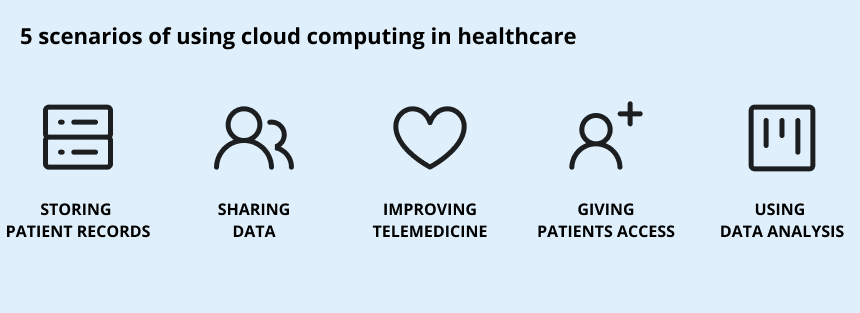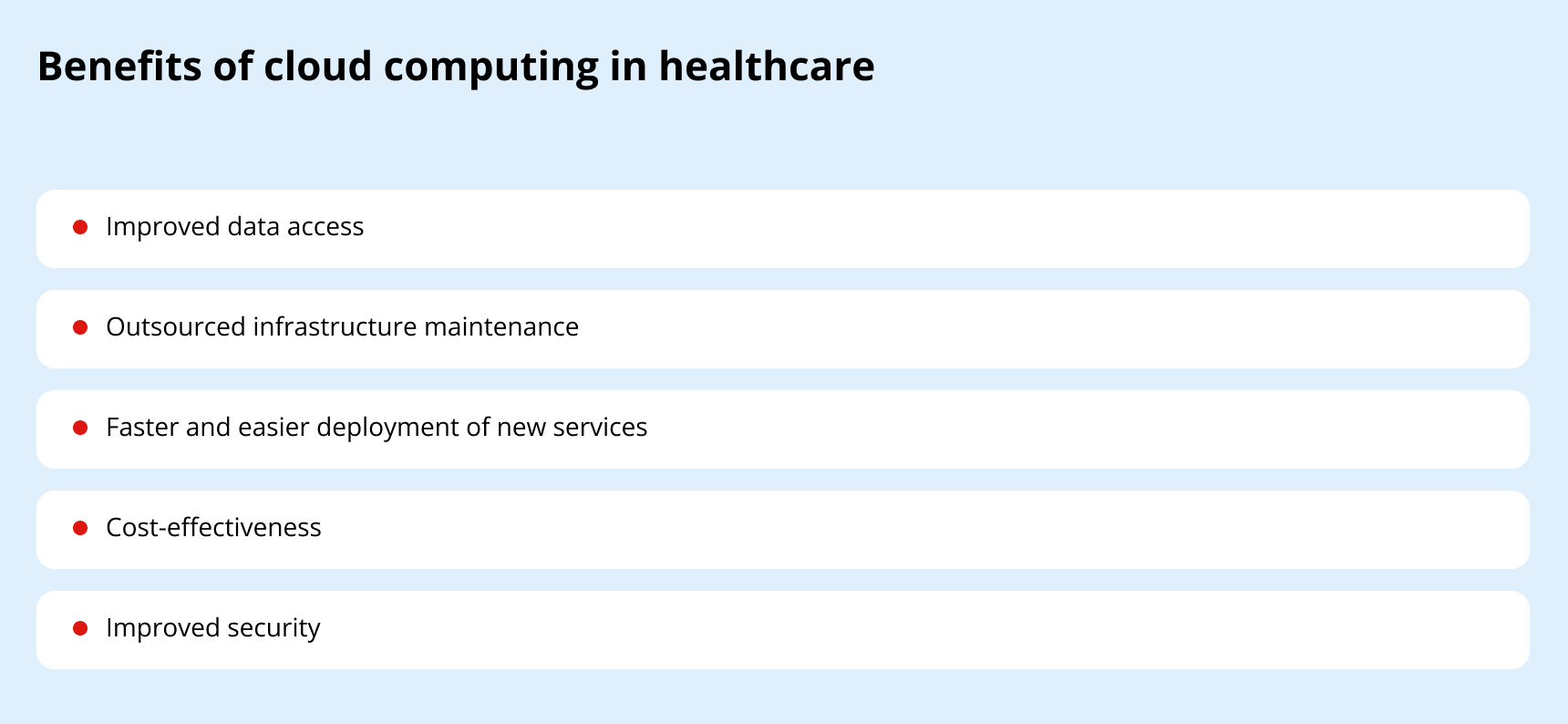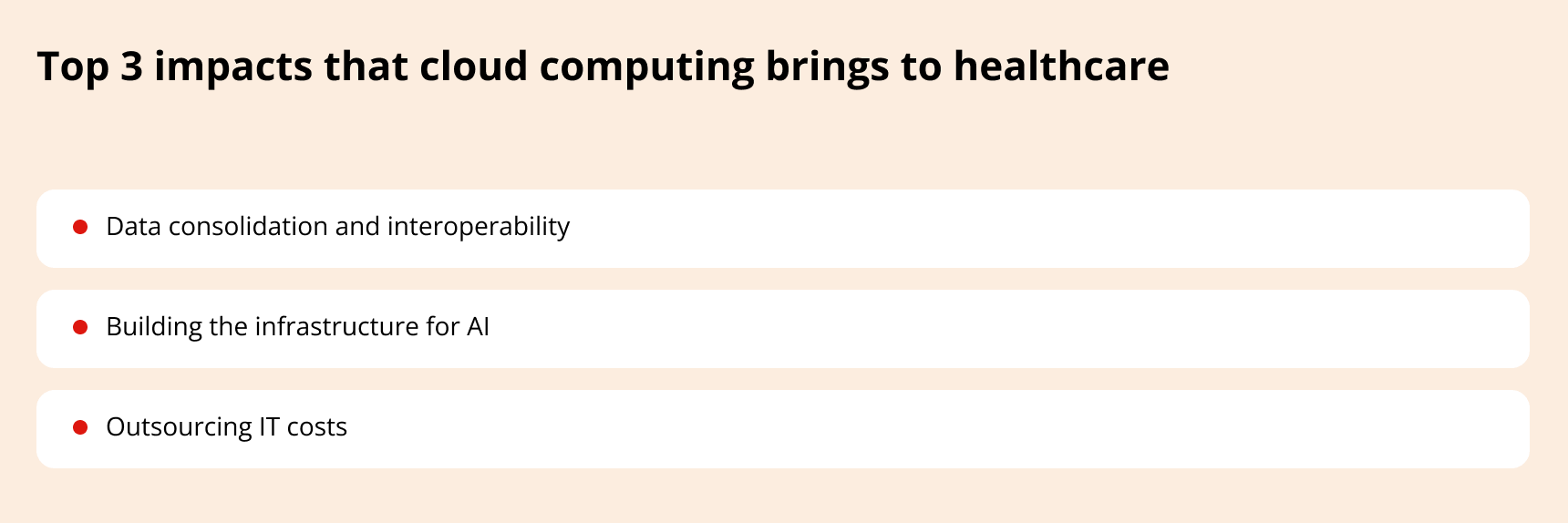Cloud Computing in Healthcare: Best Practices and Benefits
The demand for cloud computing in healthcare is growing. Why?
- Patients, clinicians, and healthcare managers are used to easy access to medical data and digital tools that help their work. Now, with the promises of AI, they expect even more.
- Keeping all this data and these tools on-site is getting too costly and hard to manage.
- The cloud seems a natural fit for their solutions.
Big tech companies like Google, Amazon, and Microsoft understand this need. That’s why they’re creating new cloud tools for healthcare. They’re also making sure their data centers meet HIPAA and GDPR rules.
Companies like Digiteum provide big data consulting and development services to connect healthcare needs with cloud solutions. We ensure a smooth transition and help healthcare organizations get the most out of cloud computing.
Here are some ideas about using cloud computing in the healthcare sector.
Cloud computing in the healthcare industry is a way of delivering healthcare data from remote servers over the internet. These servers store, manage, and process data.
Cloud computing contrasts with on-site data centers or data hosted on a personal computer.
Cloud computing includes:
- Cloud-only solutions
- Hybrid solutions
Hybrid solutions offer more variety. In a hybrid setup, some applications are in the cloud, while others stay on-site. This is perfect for companies with well-established digital systems and legacy workflows. Migrating legacy applications to the cloud is tough for them, so hybrid solutions are a great fit.
Think about all the latest solutions you’ve heard of. There’s a 99.9% chance they’re based on the cloud.

Storing patient records
In the US and Western Europe, healthcare providers are rapidly digitizing electronic health records (EHRs). In the US, 96% of hospitals and physician offices use EHRs. In the EU, some countries have even higher rates. For example, in Estonia, 99% of health data is fully digitized.
That means that the amount of data in EHRs is growing fast. It’s much easier to manage and scale this data in the cloud.
In this case, cloud computing for healthcare organizations helps:
- Consolidate clinical and claims data for analysis
- Share patient data securely
- Automate workflows
- Efficiently manage other data tasks
Sharing data
In the cloud, patient data isn’t just stored — many people actively use it. The cloud makes health information exchanges (HIEs) much easier.
When all the data is in the cloud, you can:
- Securely exchange messages, patient data, and documents
- Collaborate on treatment plans
- Schedule visits to a physician
- Use electronic signatures and cloud-based faxing
Improving telemedicine
Telemedicine surged during the pandemic and is still crucial today. In the US, over 20% of patients continue using telemedicine after the pandemic. This means tens of millions of users in just one country.
In healthcare, cloud computing makes telemedicine convenient and reliable for both HCPs and patients. The cloud:
- Provides the infrastructure for patient records, video consultations, appointments, and notifications
- Offers scalability to adjust resources as needed
- Improves security without big in-house efforts
- Allows HCPs to focus on care rather than IT infrastructure
Giving patients access
The cloud transforms how users access their healthcare data.
Before, on-site portals made it hard for patients. They had to remember many passwords and use different apps for each doctor. This caused delays and password resets.
Here are some ideas on how to improve patient engagement solutions with cloud computing:
- Simplify patient authentication across all medical data
- Introduce stronger security measures like multifactor and adaptive authentication
- Provide real-time access to medical records and test results
- Make sure patients and healthcare providers can communicate securely using messaging and video calls
Using data analysis
The healthcare industry creates huge amounts of data every day. Analyzing this data is very important for better patient care and medical research. Yet, humans can’t handle big data challenges manually.
Cloud platforms offer tools that:
- Integrate data from different sources like health records, medical devices, wearables, and genetic databases
- Consolidate the collected data on a single platform
- Provide HCPs with a complete picture of patient health
- Support personalized treatments
Let’s see why healthcare providers, big or small, are moving to the cloud or starting with cloud-only solutions these days. Here are some key benefits of using cloud computing in healthcare companies.

Improved data access
Authorized users can get healthcare data whenever they need it, from anywhere. Cloud computing also makes it simple to control who can access the data and prevents unauthorized access.
Outsourced infrastructure maintenance
Managing infrastructure on-site is expensive and complicated. When HCPs switch to cloud computing, they rely on cloud providers to handle the IT setup. This way, they save a lot on maintenance costs.
Faster and easier deployment of new services
The cloud gives you quick access to powerful tools like machine learning and natural language processing. You can deploy solutions fast without extra hardware.
Cost-effectiveness
With cloud computing, you pay only for what you need. For example, you don’t have to buy expensive data centers for disaster recovery (DR). Moving everything to the cloud can reduce DR expenses and infrastructure costs.
Improved security
When cloud providers work with HCPs, they must ensure strict data privacy to keep patient information safe. Cloud storage helps HCPs save money on storing data on-site and hiring skilled IT staff to handle data security.
Let’s see how cloud computing and healthcare work together. We’ll see three real examples where companies are fully on board with the cloud.
In these examples, companies use different cloud platforms. But what really makes a difference is the skill of your software development provider and how they maximize the advantages of cloud computing in healthcare, not just the cloud service itself.
Build a reliable cloud infrastructure
Trust Digiteum with your healthcare project — and we’ll build a solution tailored to your needs.
Contact cloud expertsCHS uses Google Cloud to consolidate data
Community Health Systems (CHS) is a for-profit operator of 71 hospitals in 15 US states. It manages healthcare services and data across its network.
Working with data from different locations and formats is a big challenge. Such a variety affects how easily they can access data and how efficiently they can provide healthcare.
To consolidate data and make it easily accessible, CHS decided to migrate its data systems to the Google Cloud. Their solution uses the Fast Healthcare Interoperability Resources (FHIR) standard. This standard defines how to exchange healthcare data across different systems. This way, FHIR helps systems work together and makes data access easier for staff.
The adoption of the Google Cloud opened more opportunities than just data consolidation. Now, CHS can:
- Use AI technologies for clinical documentation. AI automatically generates letters to insurance companies. It also gathers information on local factors impacting the health of patients who leave the hospital.
- Make data more transparent. For example, Google Cloud’s BigQuery tool gives real-time updates on metrics like bed capacity. This makes patient care better and operations more efficient.
“Beyond modernizing data infrastructure, the migration empowers CHS to innovate in AI-driven healthcare delivery, streamlining workflows and enhancing patient care delivery.” Miguel Benet, M.D., Senior Vice President of Clinical Operations, CHS.
Mount Sinai uses Microsoft Azure to cut IT costs
Mount Sinai Health System in New York operates many hospitals and a medical school. They used to have 13 data centers spread out across different places to store all their data. Of course, it was expensive to maintain them. They also had issues with possible outages and couldn’t scale up easily for new digital projects and innovations.
With these challenges in mind, Mount Sinai chose to switch to cloud computing.
They went with a hybrid cloud strategy. Mount Sinai selected Microsoft as their cloud provider. The aim was to consolidate their data centers, move workloads to the cloud, and make the solution more resilient and efficient.
Moving to the cloud cut down on the number of on-site data centers. It also boosted DR capabilities and freed up space across multiple locations.
Other benefits include:
- Saving a lot of money. Now, Mount Sinai doesn’t need to fix up facilities and spends less on IT.
- Improving security. The cloud provider makes sure the systems stay up and running without investments into extra hardware.
- Increased agility and scalability. The HCP has more chances to try new business models and innovations like AI.
This way, Mount Sinai’s move to the cloud not only solved immediate data center issues and helped save money. It also opened new opportunities for new tech products and their fast implementation.
Diaceutics uses AWS to streamline collaboration
Diaceutics specializes in data analytics for precision medicine. Their cloud platform DXRX, enables precision medicine initiatives by connecting healthcare companies with quality diagnostic testing data. Pharma and other healthcare organizations use this platform to access precise data for their projects.
Diaceutics needed a solution to support data from different sources in various formats. They teamed up with Digiteum to speed up the development of their platform.
Our team has been working on several tasks for the project:
- Building a microservices API-driven system to connect core tech with other components easily
- Integrating multiple AWS services and third-party solutions for more functionality
- Applying best DevOps practices to develop and deploy updates quickly and efficiently
- Designing and supporting ETL pipelines to deliver data from different sources to the user on request
Today, DXRX offers the following benefits:
- Easy access to data. Precision medicine and pharma companies can securely get anonymized diagnostic data they need in minutes, rather than spending weeks or months on costly research.
- Security. The platform was built with a security-first approach. It ensures the safety of sensitive healthcare data.
- Quick analytics. Users get fast access to all collected data using built-in visualization tools. This helps them generate necessary insights quickly.
Get a custom architecture for your project
With microservices, you get a solution that fits your needs perfectly.
Discover our servicesSo, what do these examples tell us about the near future of cloud-based healthcare?

Data consolidation
Today, patients and HCPs using health products juggle multiple separate tools. They’d much prefer integrated solutions that can handle a lot of different challenges all at once, rather than needing a separate tool for each task.
Data consolidation is key for these solutions. And cloud computing is right at the heart of it. It gathers data from all sorts of different places stored in the cloud, piecing it all together into a complete picture. This way, healthcare providers can build solutions that cover everything they need.
The real challenge is getting data from different systems to work together smoothly. That’s why we see a growing demand for interoperability solutions.
Building the infrastructure for AI
AI, one of the major health tech trends, is set to change everything, and healthcare is no exception. Big tech companies like Google, Microsoft, and Amazon are rolling out new AI products. These tools will make everyday tasks easier and cut down on paperwork in healthcare.
These ready-to-use tools make it easier for healthcare providers to set up AI infrastructure. With support from IT specialists, they can integrate these tools seamlessly and ensure they meet safety and compliance standards.
Outsourcing IT costs
Talking about IT specialists. When healthcare providers need help with cloud technologies, they’ve got choices:
- They can hire engineers to build what they need
- They can choose the software team augmentation model and bring in experts from software companies to boost their team
- Another option is to let an outside team handle the project
There’s no one-size-fits-all answer. It all depends on what works best for each provider’s situation.
As experts in cloud computing since 2010, Digiteum doesn’t just build cloud solutions. Instead, we offer tech strategies.
Our team guides our clients through their entire cloud journey.
- We start with a strategic understanding of your drivers, goals, and requirements. At Digiteum, we believe that this deep understanding is the most critical component of a successful healthcare client’s IT infrastructure.
- We conduct thorough discovery, assess existing infrastructure, and develop a roadmap.
- Only then do we start designing a cloud foundation and/or migrating applications or infrastructure.
- During the process, our team prepares the cloud, rolls out the transition, and makes sure everything runs smoothly in the new environment.
Healthcare is changing quickly. It’s a competitive market with high patient expectations and different care models. To address these challenges, healthcare needs powerful solutions.
Cloud computing, as part of medical software development, plays a big role. It reduces costs, supports growth and innovation, and guarantees patient safety. Cloud computing sets the stage for personalized healthcare and patient-centric treatment.
FAQ
- Private
- Hybrid
- Public
- Software as a Service
- Infrastructure as a Service
- Platform as a Service
- Security issues
- Lack of data standardization and interoperability rules
- Budget restrictions
- High competition for IT experts
- The Department of Veterans Affairs (VA) in the US uses cloud-based telehealth solutions. VA holds video consultations, uses remote monitoring, and invests in telestroke programs.
- Stanford Health Care uses the cloud for AI solutions. For example, their system automatically writes responses to patient notes for clinicians.
- UMass Memorial uses the cloud to connect patients with hard-to-access drugs. The cloud helps clinicians monitor their condition and drug reactions.







